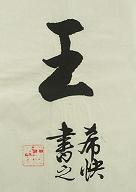How to write Chinese calligraphy - The way to hold the brush
To practice calligraphy, you must learn the proper way to hold the brush. This has much to do with the body's posture. You must hold the brush properly and also learn how to use your wrist and elbow while writing.
| Your posture while you write depends on the size of the characters you intend to write and your physical conditions. Proper posture will affect the speed of your progress and also your health. A contemporary calligrapher named Tang used the wrong posture, and though he became a calligrapher, he became a hunchback as well. He is called Tang the Hunchback.
What is the correct posture for writing? When sitting, the body should be erect, the shoulders balanced and the back straight. The legs should be apart, the feet evenly and firmly on the ground. The paper is held down by the left hand. The right hand holds the brush. The head is slightly forward, but be careful not to bow too low. Fix your eyes on the spot where you intend to write. Your eyes and the tip of your writing brush should be thirty centimeters apart. Your whole body should feel natural; do not pay undue attention to posture, or your body will become stiff or rigid. Correct posture simply prevents deformity of your body and enables you to write well. If you write characters larger than ten centimeters, you have to stand up and write. You may use any appropriate posture, depending on the situation. | | | | Proper posture for writing while seated. | | | Proper posture for writing while standing. | |
| The important thing about holding the brush is the rational way of holding the five fingers and the coordinated use of these fingers. The functions of the five fingers are called ye, ya, gou, ge and di in Chinese.
Ye means to press down and refers to the use of the thumb. The thumb should press the brush slantwise from inside to outside. Ya refers to how the index finger holds the brush handle. Move the finger slantwise and bend it slightly from outside to inside. The index finger and the thumb coordinate, so that one presses and the other holds the brush handle.
Gou (hook) is the way the middle finger hooks the outside of the brush. Move this finger forcefully from left to right to hook the brush. The middle finger must coordinate well with the third finger to write characters. Ge refers to the way the third finger press the brush. The third finger is placed on the inside of the brush handle pressing the handle from the inside to the outside. It coordinates with the middle finger, so that the two fingers exert an even and balanced force.
Di refers to the work of the little finger, which is placed under the third finger to help it.
The important points in holding the brush are: The fingers must exert substan tial force. The palm does no actual work. Xu Chengyi, a calligrapher, recommends the following:
The tiger's mouth is like a crescent moon.
The palm is shaped like hiding an egg.
If the five fingers coordinate with each other,
The movement of the brush will be agile. | | | | Holding the brush | | | Supported wrist method. | |
| Besides the fingers, one must use the wrist and elbow to write Chinese characters. The wrist is crucial and must be used with agility. You use the wrist to manipulate the tip of the brush. The four positions of the wrist are: rest, cushion, lift and suspend.
Rest the wrist of your right hand on the table. This will enable you to use your fingers well. Employ this method when you are writing very small characters-as small as the head of a fly, the Chinese say.
Cushion the wrist of your right hand. Usually you cushion it with your left thumb or your left wrist. This lifts your right wrist. This method is very often used for writing ordinary small characters.
Lift your right wrist from the table. Some people also call it suspending the wrist. It is used to write medium-sized characters.
The last position is to suspend both the wrist and the elbow. Neither touches the table. This method is used to write big characters.
These four wrist positions are only relative. If you intend to raise your calligraphy to the level of art, you must practice the suspended-wrist position from the very beginning. Would-be calligraphers must not be afraid of difficulty. They must acquire this basic skill. | | | | Raised wrist method. | | | Suspended wrist method. | |
Book References Guo, Bonan 1995. Gate to Chinese Calligraphy. Beijing: Foreign Languages Press.
Source : http://www.chinavoc.com/arts/calligraphy







